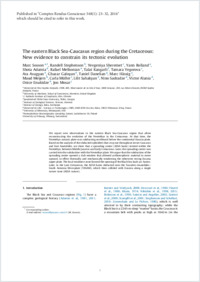The eastern Black Sea-Caucasus region during the Cretaceous: New evidence to constrain its tectonic evolution
- Sosson, Marc Université de Nice Sophia Antipolis, CNRS, IRD, Observatoire de la Côte d’Azur, UMR Géoazur, 250, Sophia Antipolis, France
- Stephenson, Randell University of Aberdeen, School of Geosciences, Aberdeen, United Kingdom
- Sheremet, Yevgeniya I. Subbotin Institute of Geophysics, Kiev, Ukraine
- Rolland, Yann Université de Nice Sophia Antipolis, CNRS, IRD, Observatoire de la Côte d’Azur, UMR Géoazur, 250, Sophia Antipolis, France
- Adamia, Shota Javakhishvili Tbilisi State University, Tbilisi, Georgia
- Melkonian, Rafael Institute of Geological Sciences, Yerevan, Armenia
- Kangarli, Talat Institute of Geology, Baku, Azerbaijan
- Yegorova, Tamara I. Subbotin Institute of Geophysics, Kiev, Ukraine
- Avagyan, Ara Institute of Geological Sciences, Yerevan, Armenia
- Galoyan, Ghazar Institute of Geological Sciences, Yerevan, Armenia
- Danelian, Taniel Université de Lille - Sciences et Technologies, CNRS, UMR 8198 Evo-Eco-Paleo, 59655 Villeneuve d’Asq, France
- Hässig, Marc Université de Nice Sophia Antipolis, CNRS, IRD, Observatoire de la Côte d’Azur, UMR Géoazur, 250, Sophia Antipolis, France
- Meijers, Maud University of Minnesota, Minneapolis, USA
- Müller, Carla Nannoplankton biostratigraphy consulting, Santok, Poland
- Sahakyan, Lilit Institute of Geological Sciences, Yerevan, Armenia
- Sadradze, Nino Javakhishvili Tbilisi State University, Tbilisi, Georgia
- Alania, Victor Javakhishvili Tbilisi State University, Tbilisi, Georgia
- Enukidze, Onice Javakhishvili Tbilisi State University, Tbilisi, Georgia
- Mosar, Jon University of Fribourg, Fribourg, Switzerland
-
2016
Published in:
- Comptes Rendus Geoscience. - 2016, vol. 348, no. 1, p. 23–32
English
We report new observations in the eastern Black Sea-Caucasus region that allow reconstructing the evolution of the Neotethys in the Cretaceous. At that time, the Neotethys oceanic plate was subducting northward below the continental Eurasia plate. Based on the analysis of the obducted ophiolites that crop out throughout Lesser Caucasus and East Anatolides, we show that a spreading center (AESA basin) existed within the Neotethys, between Middle Jurassic and Early Cretaceous. Later, the spreading center was carried into the subduction with the Neotethys plate. We argue that the subduction of the spreading center opened a slab window that allowed asthenospheric material to move upward, in effect thermally and mechanically weakening the otherwise strong Eurasia upper plate. The local weakness zone favored the opening of the Black Sea back-arc basins. Later, in the Late Cretaceous, the AESA basin obducted onto the Taurides–Anatolides–South Armenia Microplate (TASAM), which then collided with Eurasia along a single suture zone (AESA suture).
- Faculty
- Faculté des sciences et de médecine
- Department
- Département de Géosciences
- Language
-
- English
- Classification
- Geology
- License
- License undefined
- Identifiers
-
- RERO DOC 277688
- DOI 10.1016/j.crte.2015.11.002
- Persistent URL
- https://folia.unifr.ch/unifr/documents/305127
Statistics
Document views: 76
File downloads:
- mos_ebs.pdf: 173
